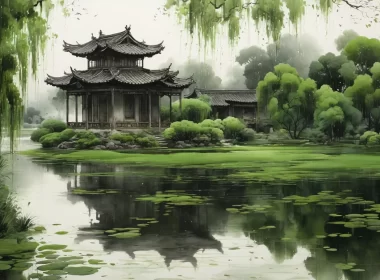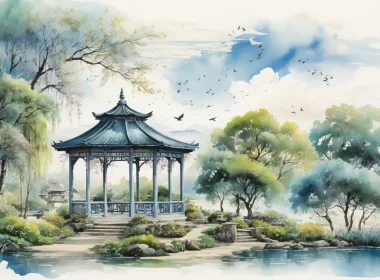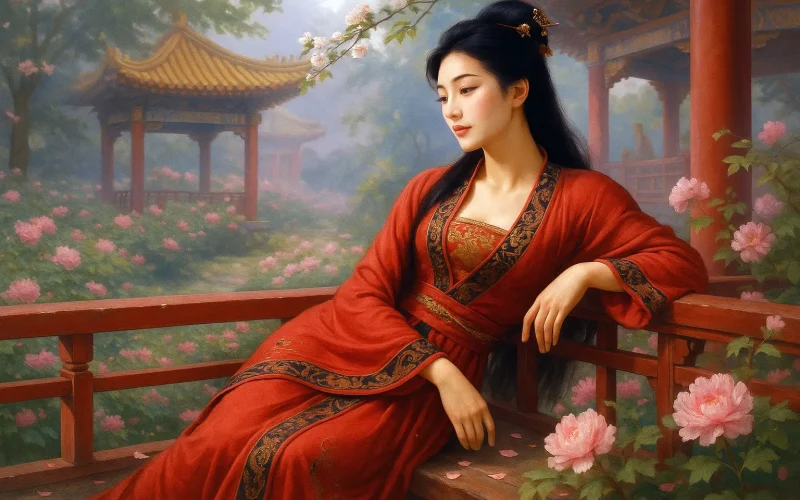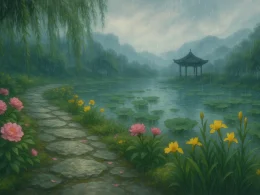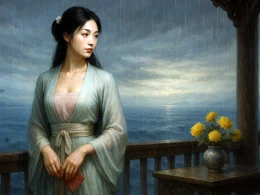Lovely now toget her, his lady and his Rowers
Lighten for ever the Emperor 's eye,
As he li stens to the sighing of the far spring wind
Where she leans on a railing in the Aloe Pavilion.
Original Poem
「清平调 · 其三」
李白
名花倾国两相欢,常得君王带笑看。
解释春风无限恨,沈香亭北倚阑干。
Interpretation
This poem depicts Emperor Xuanzong's profound affection for Lady Yang, showcasing the emperor's devotion to his beauty and their boundless joy. As one of the most renowned beauties of the Tang dynasty, Lady Yang enjoyed exceptional favor from the emperor. Through delicate descriptions, Li Bai conveys their special bond, particularly highlighting Xuanzong's tenderness towards Lady Yang. However, the poem seems to contain subtle irony, revealing the hidden concerns behind such favor.
First Couplet: "名花倾国两相欢,常得君王带笑看。"
Míng huā qīng guó liǎng xiāng huān, cháng dé jūn wáng dài xiào kàn.
A famed flower that captivates the nation, bringing mutual delight, often gazed upon by the emperor with smiling admiration.
The "famed flower" metaphor represents Lady Yang's beauty, emphasizing her status as the dynasty's most stunning woman and the emperor's beloved. "Captivates the nation" describes her overwhelming charm, further highlighting her allure to the emperor. "Mutual delight" expresses their deep affection and harmony. "Smiling admiration" vividly portrays Xuanzong's doting gaze, creating an atmosphere of happiness. Yet beneath this seemingly perfect relationship may lie criticism - the emperor's indulgence in pleasure and neglect of state affairs ultimately led to the dynasty's decline.
Second Couplet: "解释春风无限恨,沈香亭北倚阑干。"
Jiě shì chūn fēng wú xiàn hèn, shěn xiāng tíng běi yǐ lán gān.
The spring breeze dispels endless sorrow; she leans against the railing north of the Chenxiang Pavilion.
"Spring breeze" symbolizes warmth and favor, representing both natural breeze and imperial affection that soothes Lady Yang's melancholy. "Endless sorrow" suggests not resentment but longing after separation or lament for fleeting happiness. "Leaning against the railing" paints an exquisite picture of Lady Yang in contemplation, perhaps reveling in joy or sighing over time's passage. Beneath this beauty lies political crisis and life's impermanence.
Overall Appreciation
The poem portrays their harmonious love through descriptions of Lady Yang's beauty and Xuanzong's affection. The "spring breeze" imagery conveys imperial favor while hinting at time's transience, adding melancholy to the deep affection. Beneath the celebration of love lies critique of the ruler's indulgence that ultimately caused the An Lushan Rebellion, marking the dynasty's tragic decline.
Writing Characteristics
- Metaphorical language: The "famed flower" metaphor vividly depicts Lady Yang's beauty
- Dual symbolism: "Spring breeze" represents both nature and imperial favor, enriching meaning
- Visual imagery: Detailed descriptions transport readers to the Chenxiang Pavilion
- Layered emotions: Conveys both romantic bliss and subtle lament over time's passage
- Critical undertones: While praising their love, it implicitly critiques the emperor's neglect of governance
Insights
The poem presents idealized love while acknowledging how reality intertwines romance with power and fate. Beyond celebration, Li Bai may be warning how transient beauty and unchecked indulgence invite historical consequences. This Tang masterpiece thus becomes both a love song and cautionary tale about the perils of power.
Poem translator
Kiang Kanghu
About the poet

Li Bai (李白), 701 - 762 A.D., whose ancestral home was in Gansu, was preceded by Li Guang, a general of the Han Dynasty. Tang poetry is one of the brightest constellations in the history of Chinese literature, and one of the brightest stars is Li Bai.



